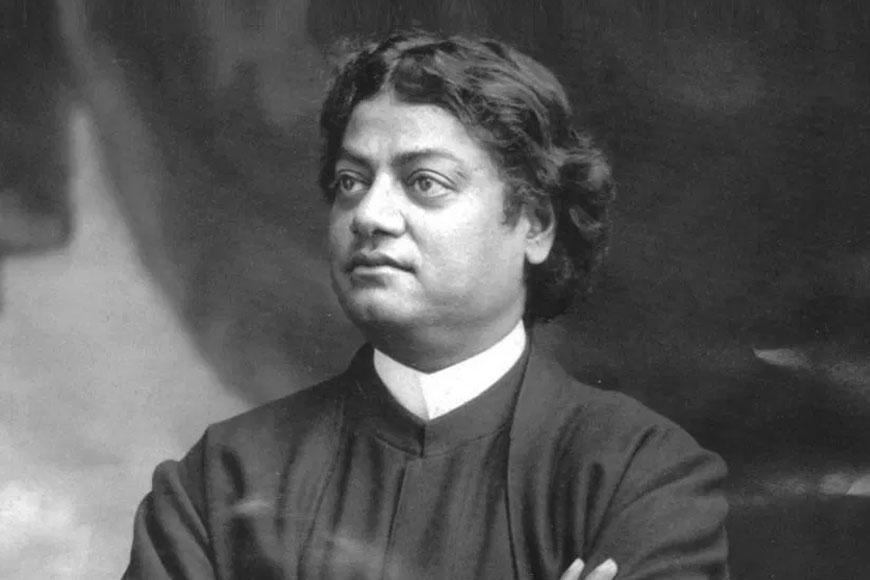Swami Vivekananda’s love for Khichuri and his special recipe - GetBengal story

Khichuri has always been the reigning queen of Bengali kitchens. There is an interesting anecdote in the ‘Manasamangal Kavya’, the oldest of the Mangal-Kāvyas where Goddess Durga orders her husband, Lord Shiva’s personal attendant, Nandi to fetch green coconuts because the ‘Lord’ has desired to consume moong-dal (yellow split gram) ‘Khichuri’ cooked in tender coconut water. As soon as Nandi hears this, he rushes in search of green coconuts.
Bengalis are food connoisseurs and Khichuri for them is intrinsically linked to monsoon. As dark clouds cover the horizon and moisture-laden wind rustle, swaying the treetops and bushes, the pitter-patter begins. Soon it turns into a steady drizzle and then gradually intensifies into a thundershower. Ask any Bengali about the day’s food preference and in all likelihood, you will be first chided and then the final diktat will be announced: “This is THE perfect weather for Khichuri. What else?!” You get your answer.
Swami Ji’s Khichuri recipe includes an equal amount of rice and moong Dal (yellow split gram) to which different types of seasonal vegetables are added including, potato, cauliflower, peas, ridge gourd and colocasia or alocasia. To accompany the piping hot Khichuri, he cooked the world-famous ‘Chatni’ (sauce) with ripe tomatoes, pumpkin and ‘Amra’ (Indian hog plum).
But did you know even Swami Vivekananda had a special khichuri recipe? He was a foodie and before he met his spiritual guru, Ramakrishna Paramhansa, he was the founder of ‘Petuk Sangha’ aka Greedy Club. One of the prime research project of the members of the club involved myriad experiments with ingredients and methods of rustling different types of Khichuri. Naren aka Vivekananda’s enthusiasm for cooking continued even after he met Ramakrishnadev. The ‘Bhog’ offered to the deities during the annual Durga Puja was introduced at Belur Math by none other than Swami Vivekananda. He was eagerly involved in the entire planning and execution of the ‘Bhog’ in the kitchen. The Khichuri recipe that he introduced in the latter half of the 18th century continues to be followed at the mission to this day. Renowned Bengali author, Shankar (Manishankar Mukhopadhyay) reveals the world’s best Khichuri is cooked at Belur Math.
Swami Ji’s Khichuri recipe includes an equal amount of rice and moong Dal (yellow split gram) to which different types of seasonal vegetables are added including, potato, cauliflower, peas, ridge gourd and colocasia or alocasia. To accompany the piping hot Khichuri, he cooked the world-famous ‘Chatni’ (sauce) with ripe tomatoes, pumpkin and ‘Amra’ (Indian hog plum). When Swami Ji travelled abroad, he procured the raw ingredients locally and cooked his sauce. He carried the exotic spices needed to cook his meals abroad in the pockets of his saffron robe. These included everything from green chilies to ‘Paanch phoron.’ He carried a big packet of ‘Moong daal’ (yellow split gram) with him but when his provision would be exhausted, he would write letters to parcel him packets of lentils. Vivekasnanda preferred fried potato fritters with Khichuri. He peeled the potatoes so deftly that even Ma Sarada praised Naren’s expertise.
The term khichri (khicṛī) is derived from the Sanskrit khiccā, a dish of rice and legumes. Greek king Seleucus during his campaign in India (305-303 BC), mentioned that rice with pulses is very popular among people of the Indian subcontinent. Moroccan traveller Ibn Battuta visited India around 1350 and he mentions kishri as a dish made of rice and mung beans (yellow split gram). Khichri is described in the writings of Afanasiy Nikitin, a Russian adventurer who travelled to the Indian subcontinent in the 15th century. It was very popular with the Mughals, especially Jahangir. Abu'l-Fazl ibn Mubarak, Mughal Emperor Akbar's vizier mentions the recipe for khichri in his book ‘Ain-i-Akbari’. The last independent Nawab of Bengal, Siraj ud-Daulah (1733 - July 2, 1757) was also very fond of mung daal Khichuri. The popular Anglo-Indian dish ‘Kedgeree’ is thought to have derived from khichri.
But did you know even Swami Vivekananda had a special khichuri recipe? He was a foodie and before he met his spiritual guru, Ramakrishna Paramhansa, he was the founder of ‘Petuk Sangha’ aka Greedy Club. One of the prime research project of the members of the club involved myriad experiments with ingredients and methods of rustling different types of Khichuri. Naren aka Vivekananda’s enthusiasm for cooking continued even after he met Ramakrishnadev.
It is a well-known fact that Chaitanyadev was very fond of Khichuri and it is known as ‘Maha-bhog’ among devotees. The Khichuri distributed to devotees at Puri’s Lord Jagannath Dev’s temple is known as ‘Jaga-Khichuri’ (potpourri or mish-mash of rice, lentils and vegetables). Kashimiri Pundits offer Khichuri to Lord Kuber, the presiding deity of the Yakshas and it is known as Khetsimavas. In Tamil Nadu, Khichuri is known as ‘Pongal.’ In Rajasthan, a light, nutritious form of Khichuri is cooked and it is known as ‘Tehri.’ In Maharashtra, mustard seeds are mixed with Khichuri. The great hermit and physician Charak had mentioned that the nutritious value of Khichuri is no less than Pulao/ Pilaf.
In fact, Indian Khichuri conquered Great Britain way back in the 19th century, during the time of Queen Victoria’s reign (1837-1901). The Brits love a good curry as much as they love Khichuri. So where did it come from and how did it become such a national favourite? The Brits colonized India and our Khichuri enslaved their taste buds and won the epicurean battle hands down. Now, on a lighter note, that’s what is called a sweet revenge.










